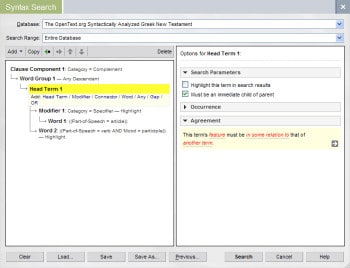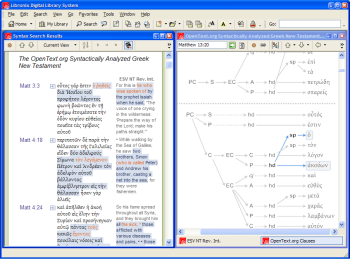I was talking with Daniel Foster yesterday afternoon. We were talking about syntax search examples and how they’re different than other sorts of morphological searches.
One type of search that we used to rely on the Graphical Query Editor to do (and still do; we didn’t take this capability away) was to do what is generally known as “agreement searching”.
An example would be: Find where two words exist N words apart (where, say, N = 5) and the two words agree on some sort of morphological criteria (like, say, case, number or gender).
This sort of approach is commonly used to find where a noun or participle has an article, or where an adjective is associated with a noun. Things like that. In essence, we approximate an established syntactic relationship using proximity (within N words) and morphological criteria (sharing same case, number and gender).
What we really want, though, is where an article modifies a participle or noun. That is, where the article and participle have an established relationship. The number of words that separate them is incidental, they could be next to each other or they could be 15 words apart. We’re interested in the specific relationship.
The good news is: This search can be done in the New Testament with an underlying syntactic database. Since we’ll be searching the entire New Testament, we’ll use the OpenText.org Syntactically Analyzed Greek New Testament, which has been discussed previously on this blog.
The better news is: We can do even more — like, say, find where participles have an article that modifies, and where the “articular participle” is (for example) in the Complement (object) of a clause. Like what the below syntax search specifies.
First we need to understand some of the terminology that the OpenText.org GNT uses to specify syntactic relationships. Below is a quick primer:
- clause component: Essentially the subject, verb and object portions of the clauses. OpenText.org use the labels Subject, Predicator and Complement (respectively). These are groups of words that may or may not be contiguous. The OpenText.org clause annotation also has Adjunct and Addressee components.
- word group: Clause components consist of one or more word groups. A word group is, basically, a group of words. The word group consists of, at minimum, a head term. The head term may optionally have modifiers.
- head term: The head term is the one word in the group that all of the other words (if any) modify. An English example: “Paul, an apostle”. In this example, “Paul” is the head term. The rest of the group is in a modification relationship to Paul.
- modifier: Modifiers are subgroups (perhaps even nested) that modify head terms or other modifiers. There are four different kinds of modifiers in the OpenText.org annotation: specifiers (typically prepositions and articles), definers (typically adjectives and things in apposition), qualifiers (typically genitive sorts of things) and relators (typically when a prepositional phrase serves to modify a head term or another modifier).
In the above example of “Paul, an apostle”, the word “apostle” further modifies the head term “Paul”. The word “an” further modifies “apostle”. Assuming an annotation that encodes such things (and the OpenText.org annotation does encode such things), this means that one can specify a search to find where “apostle” modifies “Paul” not just where they happen to occur in close proximity, but where there is an established relationship. Proximity is a helpful guide, but it can also produce false positives. By starting to consider established relationships as the basis for searching, we’re moving into the realm of searching for syntactic relationships … and outside of the realm of morphological happenstance.
Now, let’s apply all of this. To find an “articular participle”, we would look for a word group where a participle is a head term, and where that participle-as-head-term is modified by a specifier that is an article.
We can take that a step further and specify that the word group in question occurs in the Complement (i.e., the object) of the clause. Sort of like the above image showing a syntax query. This will locate where articular participles occur within the Complement (object) of a clause.
Of course the above image helps somewhat, but why not view a video of the construction of the search? That’s what I thought, so I did a video capture of the process for y’all. (Video: Flash, approx. 4.6 megs, no sound, 3:14)






